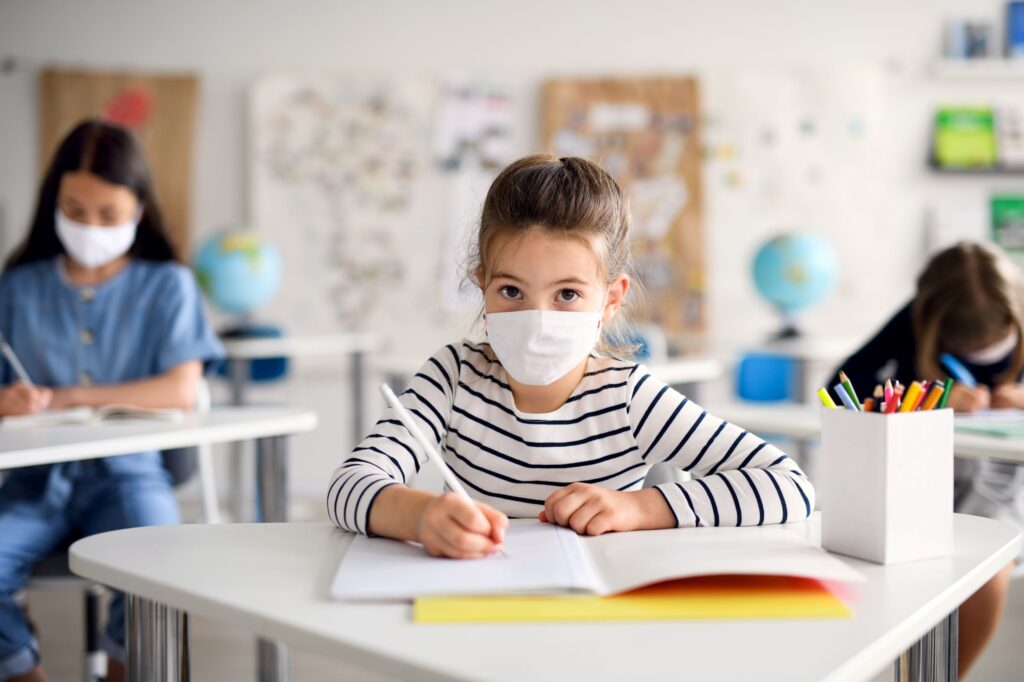A Message on COVID-19 from WorkSTEPS Chief Medical Officer Dr. Ben Hoffman:
Back to School (?): Implications and Actions for Businesses
For months, school districts across the country have been gathering information, running scenarios and making decisions that will determine where and how instruction will resume in the fall. They have had to choose among a short list of bad options – all with serious drawbacks.
All of this has taken a toll on families with children or grandchildren in school as they are forced to grapple with a host of issues. Who will be at home to supervise and support online learning? Will our children be safe if they return to school? What if our child gets sick and brings it home to a vulnerable family member? How do we adjust if there is a breakout in school and we have to adapt to online instruction at a moment’s notice? How do we help our kids understand what’s going on and cope with the psychosocial impacts of all this?
School Challenges = Business Challenges
Of course, as employees invest their time, effort and attention (a.k.a. human capital currencies) to solve the types of issues noted above, it affects their productivity and ability to return to work. And impacts on individual employees typically ripple through teams, departments, and projects, affecting relationships, productivity and performance on a larger scale.
Notably, COVID-19 is a fluid situation. Maybe your community’s schools are opening with in-person instruction. But if an infection outbreak occurs in a school, CDC Guidance for Schools and Child Care recommends a 2-5 day shut-down for disinfection and contact tracing, forcing families to quickly adapt.
Finally, it’s worth noting that with few exceptions, students will be negatively impacted by these changes and disruptions. Today’s students are tomorrow’s workforce, so businesses have a stake in helping schools navigate these challenges.
Easing the Strain
As I see it, there are three basic ways that businesses can help reduce the impact of COVID-19 on schools, families, and their own business operations:’
- Help Reduce Community Spread: Per CDC Guidance, the greater the level of community spread, the more restrictive schools should be about offering in-person instruction. Also, high rates of community spread increase the chances of student infection, which will trigger shutdowns and accompanying disruptions.
- To help reduce the spread of COVID-19, businesses should implement comprehensive COVID-19 prevention strategies (including HVAC adjustments), educate and equip employees to practice preventive behaviors outside of work, and push for sensible controls like face mask requirements and bans on super-spreader events.
- Help Schools and Teachers Adapt: The list of needs faced by your local schools is long. A friend of mine shared notes he took on a recent Zoom call with his local Rotary club. A teacher ticked off a long list of needs, including help with HVAC systems to improve air flow, sanitation supplies, substitute teachers, musical instruments and art supplies, and high-speed internet access for rural students with poor connections. Contact your administrators and teachers, see what they need and figure out how your organization can help.
- Support Your Employees with Kids in School: While there will always be a need to address individual situations, focus on developing policies and programs that anticipate and support your working parents. Use surveys and focus groups to understand what employees are up against and engage parents in helping to develop reasonable policies and programs to help them best meet home and work expectations during these unprecedented times.
COVID-19 is a global pandemic, but its impact on our communities, families and businesses has always been what matters most to us. As employers, we all have a lot at stake in how well our communities control the virus, how effectively our schools implement prevention strategies, and how efficiently our families adapt to changing conditions. And thankfully, businesses have a lot of experience, talent and resources that can be put to work in helping to tackle the challenges being faced.
And before I close, a last-minute addition. As I was completing this article, I received a research update on the topic safe school openings. Some helpful information and implications that very much align with the recommendations above. Click here to view, and consider sharing with your local school administrators.
We hope that the information and resources we’ve provided through this Brief have equipped you and your company to help your local schools at this critical time.
If your company needs help developing, evaluating or implementing its COVID-19 strategy, or if you would like help with COVID-19 communications, let us know. More about our full array of services can be found here.
Ben Hoffman, MD, MPH
Chief Medical Officer, WorkSTEPS
For more from Dr. Hoffman, connect with him on LinkedIn.
Medical:
Nationwide cases: The average daily case count for new COVID-19 cases each day in the past week has been just over 60,000 cases, which is a 9% decline from the previous week. This past weekend, Alaska, Hawaii, Missouri, Montana, and Oklahoma reported the largest increases in positive COVID-19 cases.
Global recurrences: Countries that initially contained the pandemic are currently facing recent flare-ups. In Australia, an ongoing outbreak in Victoria state’s Melbourne city, has prompted stricter measures. Along with a 6-week lockdown, steps will include closure of retail businesses and some closure of administrative and construction sectors. Vietnam has announced an outbreak of infections in four factories in Danang city. The Philippines and the U.K. are also seeing similar flare-ups.
FDA issues EUA for Semi-Quantitative tests: On Monday, the FDA announced they had issued emergency use authorizations (EUAs) to Siemens for its ADVIA Centaur SARS-CoV-2 IgG (COV2G) and Atellica IM SARS-CoV-2 IgG (COV2G) tests. The tests are the first COVID-19 serology tests to provide an estimated quantity of antibodies present in a serology sample and are called semi-quantitative tests. To date, the FDA has authorized 198 tests under EUAs; these include 161 molecular tests, 35 antibody tests, and 2 antigen tests.
Vulnerable Population: Earlier this week, Eli Lilly announced a first-of-its-kind study to enroll up to 2,400 residents and staff at long-term care facilities. In the U.S, more than 40 percent of COVID-19 deaths have been linked to long-term care facilities. This will be the launch of a phase 3 trial of antibody treatment for COIVD-19 to meet an urgent need for therapeutic strategies to prevent COVID-19 in this vulnerable population.
Fauci: US COVID-19 Vaccine Likely By Early 2021 (CIDRAP): Friday during a 3-hour hearing in front of Congress on the federal response to the COVID-19 pandemic, Anthony Fauci, MD, director of the National Institute of Allergy and Infectious Diseases, said that it was a definitely a possibility the United States would have an effective vaccine against COVID-19 by early next year. His optimism comes on the same day Operation Warp Speed, the US’s COVID-19 vaccine program, announced its biggest agreement yet: $2.1 billion to Sanofi Pasteur to supply the US government with 100 million doses of its experimental coronavirus vaccine. Sanofi is working with GlaxoSmithKline on a vaccine clinical trial planned for September.
Mitigation / Suppression:
NIH antibody trial phase 2: On Tuesday, the NIH announced moving to Phase 2 of a trial to determine if monoclonal antibodies can shorten severity of COVID-19 in outpatients. Researchers will be recruiting patients at sites across the country to take part in the trial known as ACTIV-2. Volunteers will receive experimental therapy or a placebo as part of a rigorously designed randomized clinical trial. ACTIV-2 study is part of NIH’s Accelerating COVID-19 Therapeutic Interventions and Vaccines (ACTIV), a public-private partnership program to speed development of promising treatments and vaccines.
Safe reopening of colleges: Last week researchers published a study published concluding that safe reopening of US colleges during the pandemic this fall will rely on frequent screening of asymptomatic students and strict compliance to social distancing and infection-control. The study modeled a hypothetical cohort of 4,990 healthy students and 10 asymptomatic infections at the start of semester. Assuming a reproduction number (Rt) of 2.5 (a primary case infects 2.5 other people). Screening every 2 days detected 243 infections. Screening every 7 days yielded 1,840 infections. Testing frequency was more strongly tied to total infections than was test sensitivity. Less-frequent testing was linked to greater spread of infection and a higher proportion of students with confirmed positive results in isolation.
Resetting our response: Last week, researchers from Johns Hopkins Center for Health Security released a brief report with recommendations urging the nation to reset our current response. The brief described policy actions at the federal and state levels needed to control the pandemic nationwide. Below is a summary, but in-depth recommendations linked above.

Corporate:
WHO updates their International Travel Guidelines
A recent modeling study concluded that widespread epidemics of COVID-19 could be delayed and greatly reduced if enough people consistently practiced the 3 W’s: Wear a mask, Wash your hands (or use hand sanitizer), and Watch your distance. The effect held true even if masks, hand-washing and physical distancing were only partially effective. The research also shows how these individual behaviors can limit the need for lengthy mandated lockdowns. In this in-depth review, we examine the evidence behind each of these three tools and review current recommendations.
The Work From Home WorkSTEPS Medical Team:

Ben Hoffman, MD, MPH
Chief Medical Officer

Tony Nigliazzo, MD
Medical Director

Loraine Kanyare, MSN, MPH, RN
Director of Case Management

Robert L. Levitin, MD
Physician Consultant

Lynda Phillips, LVN
Nurse Case Manager

Codey Church, LVN
Nurse Case Manager

Kerry Womack, LVN
Nurse Case Manager

Chuck Reynolds
Strategic Communications Consultant
This Guidance (“Guidance”) is provided for informational and educational purposes only. It is not intended as Legal Advice or Medical Advice. Adherence to any recommendations included in this Guidance will not ensure successful diagnosis or treatment in every situation. Furthermore, the recommendations contained in this Guidance should not be interpreted as setting a standard of care or be deemed inclusive of all proper methods of care nor exclusive of other methods of care reasonably directed to obtaining the same results. The ultimate judgment regarding the propriety of any specific therapy must be made by the physician and the patient in light of all the circumstances presented by the individual patient, and the known variability and biological behavior of the medical condition. Similarly, this Guidance is based on current advice, comments, and guidance from the EEOC, CDC and the CMS made publicly available. The ultimate judgement regarding the propriety of any specific employment action must be made by the company and attorney in light of all of the circumstances presented by the company, state and federal rules existing at the time and the then current state of the National Pandemic. This Guidance and its conclusions and recommendations reflect the best available information at the time the Guidance was prepared. The results of future studies or changes in rules, regulations or laws may require revisions to the recommendations in this Guidance to reflect new data. WorkSTEPS does not warrant the accuracy or completeness of the Guidance and assumes no responsibility for any injury or damage to persons or property arising out of or related to any use of this Guidance or for any errors or omissions.




